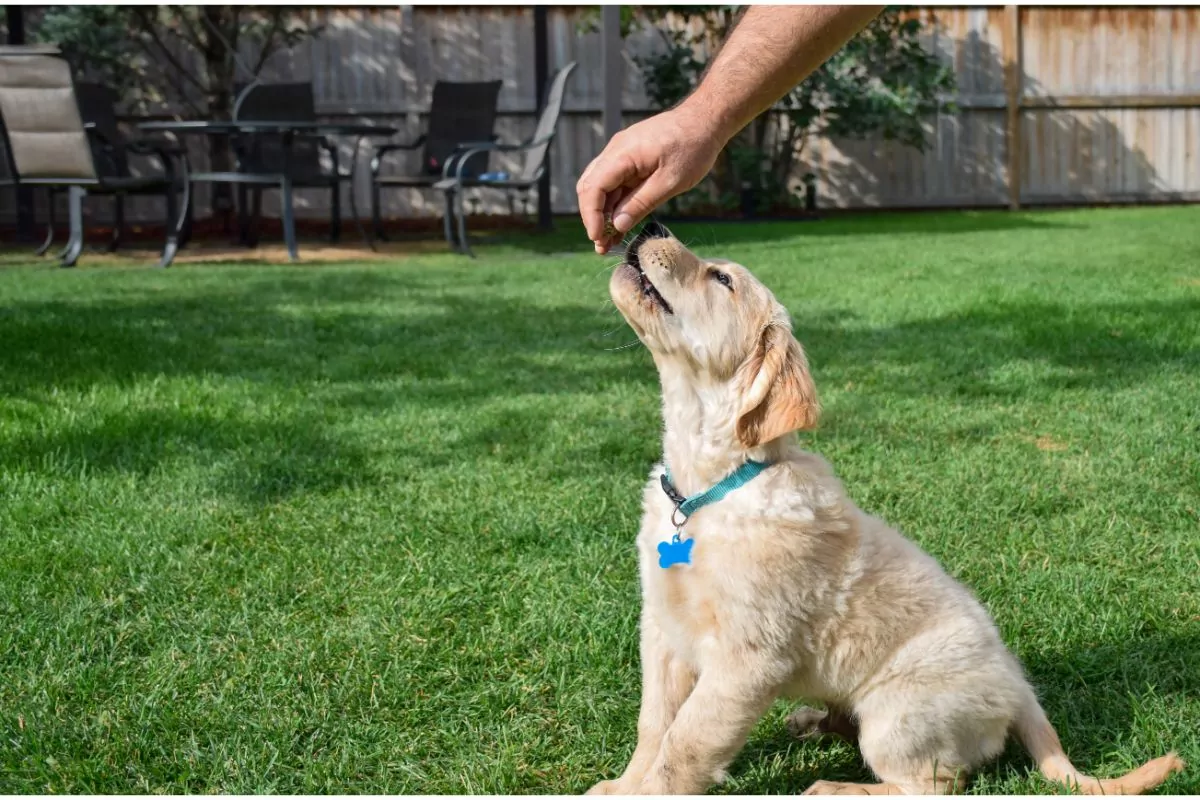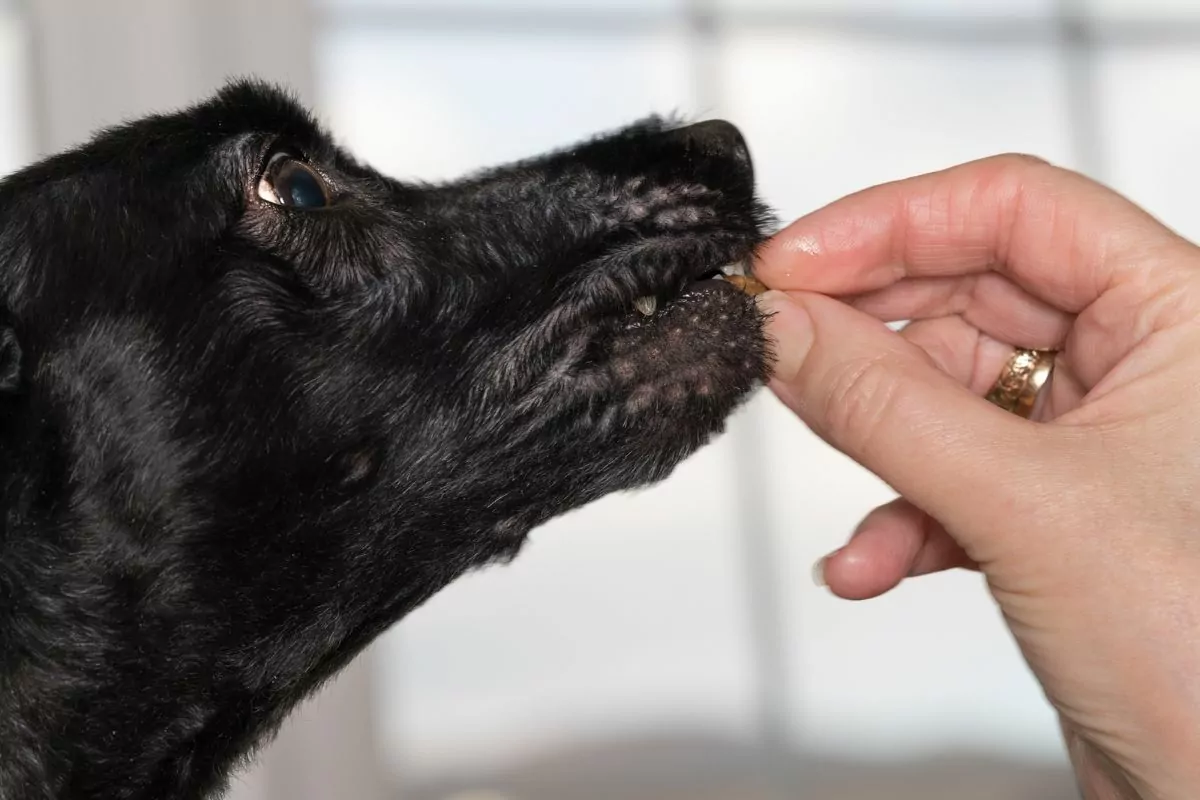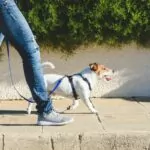NexGard is advertised as a monthly tick and flea preventive medicine, which is available in the form of a handy chewable treat.
You might well believe that a product released into the market with the aim to protect dogs wouldn’t ever harm them.

Ever since it was permitted for veterinary usage, it has been drawing criticism from dog owners who have experienced awful side effects in their dogs.
Most dog owners learn about NexGard’s negative aspects when it’s far too late for their animals. If this is the first time you have heard of this product, or you want to know more, then you have come to the right place.
In this article, we will discuss everything you need to know about NexGard and whether you should be giving this treatment to your dogs.
What Is Inside NexGard?
Afoxolaner, a pesticide belonging to the isoxazoline family of chemicals, is the active component of NexGard. This ingredient is supposed to kill fleas before they can lay their eggs. Hence, it will reduce fleas from contaminating the dog’s environment.
The other active ingredient found in NexGard is milbemycin oxime. It is said to treat internal parasites in both cats and dogs.
Both of these ingredients can be found in a broad range of FDA approved products, which are given to dogs for flea and tick prevention.
NexGard Attacks The Nervous System
Isoxazolines are known for being neurotoxic. As a result, they are successful since they target the insect’s such as ticks or flea’s central nervous system. This then leads to a very quick death.
On NexGard’s packaging, it states that it uses a “selective toxicity” of isoxazolines. Hence, they are toxic only to insects, and mammals should be safe.
However, almost ten years’ worth of adverse effects that dog owners and veterinary specialists have reported reveal a different reality.
Isoxazolines have neurotoxic effects on mammals in addition to insects. There is an explanation why numerous dogs have been experiencing tremors, seizures, and ataxia after consuming NexGard.
The treatment is affecting the dogs’ down central nervous system. Therefore, once this happens, there is no way to reverse it.
Dog owners who choose to give their dogs NexGard are taking a risky gamble because of the product’s neurotoxicity across species.
For example, dogs that may have been completely healthy before taking NexGard, could end up having seizures after taking the treatment. There is no way to know whether this treatment will impact your own dog until it is far too late.
What Does It Say On NexGard Packaging?
NexGard was first introduced to the veterinary market in 2013 and 2014.
However, due to a large volume of reports of the serious and deadly effect of this flea and tick prevention treatment, in 2018, the packaging was changed.
The companies who created NexGard altered the packaging and added a warning about the dangerous side effects that this treatment can cause to your dog’s central nervous central system.
Now on the packaging it says the following:
“NexGlad contains afoxolaner, which is part of the isoxazoline class. This particular class of isoxazoline has been linked with various neurological reactions. This includes ataxia, tremors, and seizures.
In particular, seizures have been seen occurring in various breeds of dogs that have been consuming this particular class of drug.
Seizures have been occurring in dogs that have no previous history of seizures before taking this drug.
As a result, it is advised that you use this treatment with caution with dogs that have a history of neurologic disorders or seizures.
However, it has not been determined whether NexGard is safe to use in dogs that are breeding, pregnant, or nursing.”
Reactions Listed On The Informational Leaflet
On the included informational leaflet, you will discover that there are two sections which focus on the possible reactions that could happen.
The initial serious reactions were first discovered during the 90-day pre-approval study, which also happened to be conducted by NexGard.
These reactions included vomiting with and without blood, flaky and dry skin, lethargy, anorexia, and diarrhea with and without blood.
Alongside this, due to the 90-day pre-approval study, two dogs with a previous history of seizures unfortunately experienced a seizure caused by NexGard.
The next section of reactions that you can find on the leaflet were commonly reported by actual dog owners during the following 4 years after the initial approval of the treatment.
This includes the following reactions that were reported in decreasing frequency:
- Vomiting.
- Diarrhea.
- Lethargy.
- Seizure.
- Painting.
- Anorexia.
- Restlessness.
- Dermatitis.
- Erythema.
- Tremors.
As you can see, seizures are one of the most reported side effects of NexGard. The top reaction has been vomiting in many dogs, but this is also telling.
Vomiting is a natural sign that the dog is trying to remove something unwanted from their stomach.
In fact, by vomiting up this pesticide, this could protect the dog from the negative effects that this treatment could cause the dog.
However, this would only happen if the dog is able to completely remove the NexGard from their system.
It actually states on the NexGard leaflet that if your dog happens to vomit two hours after taking this treatment, that the owner should reduce the dose.
We would advise that you take your dog’s natural reaction as a sign that possibly there is something wrong and your dog’s body doesn’t want to consume it.

Do The Potential Benefits Outweigh Any Risks?
According to the official information about this product, it states that parasites have to begin feeding on their host, to be able to come into contact with afoxolaner.
As a result, the risk of a parasite disease cannot be disregarded.
Overall, NexGard only destroys ticks and fleas after they have bitten your dog. As a result, if a tick or flea is carrying a disease, there is a chance that this could be passed onto your dog.
Hence, NexGard doesn’t keep ticks and fleas away from your dog, which many owners would assume. Instead, it just kills them once they have begun to feed on your pet.
FDA And EMA Report On NexGard
Since it has been on the market, the FDA (Food and Drug Administration) alongside the EMA (European Medicines Agency) have been collecting reports on the effects and reactions that the drugs they have approved are having.
In fact, the FDA sent out an official warning to all vets and dog owners about the use of products containing isoxazoline.
The FDA has been letting all vets and pet owners know about the negative and possible dangerous effects that can happen in both dogs and cats who have taken drugs which contain isoxazoline.
While not every cat or dog will experience these reactions, it is still possible for it to happen. Even pets, who have no past history, are at risk of having a seizure due to the consumption of these products.
FDA Figures
We believe it is important that you are aware of how many dogs have been hurt by the chewable NexGard product.
From 2013 to 2017, it is known that the FDA discovered 801 deaths and 1,728 seizures caused by any isoxazoline product. However, 341 of these deaths were due to NexGard.
The FDA has done research into the side effects that have been reported due to isoxazoline products, including NexGard.
It has been reported that vomiting is the top reported side effect that animals have experienced, with 13,251 dogs suffering from it.
This is then followed by 9,266 reports of behavioral changes and issues after consumption. There have also been 7,502 reports of skin irritations and 4,639 owners have reported that their dogs have suffered from anorexia.
With this being said, these figures are only reporting cases within America, during the initial 4 years after many isoxazoline products such as NexGard hit the market.
Today, those numbers are potentially much higher, but the FDA makes it more difficult to find the exact numbers. It isn’t possible to find the brand names in their reports either, only the individual active ingredients used in the drugs.
EMA Figures
One of the main ingredients in NexGard is afoxolaner, which is a form of isoxazoline.
This ingredient alone has had some truly awful side effects in dogs as well, which has caused 1,261 deaths according to the EMA. In addition to this, NexGard Spectra is a combination of afoxolaner and milbemycin oxime.
These product ingredients, together in this drug, have been reported to have caused over 6,455 deaths.
The EMA, between 2013 and 2019, also looked into isoxazoline products. They discovered that pet owners reported 5,556 deaths due to these products and 6,272 seizures.
What makes these numbers even worse, is that the EMA have conducted reports that have discovered that 60% of deaths and 55% of seizures were occurring in dogs that are over 5 years old.
As a result, these treatments can be dangerous for dogs who may have had it before and not reacted. Hence, as your dog gets older, then the more likely they are to experience one of these terrible reactions.
Independent Studies On NexGard
More studies have been conducted into isoxazoline based tick and flea treatments. The most recent unbiased investigation investigating the unfavorable effects of chewable flea and tick medications was released in 2020.
The findings are based on an analysis of survey responses from vets, pet owners, and other pet carers.
Of the 1,325 users who reported taking isoxazoline products, 911 used Bravecto (fluralaner), 342 used NexGard, and the other users used Simparica (sarolaner).
A negative reaction in their dog was reported by 87% of Bravecto consumers, 69% of NexGard users, and 61% of Simparica customers.
This demonstrates once further that the negative consequences of isoxazoline products are a common occurrence.
In fact, chances are that you are the exception if you’re reading this article as a devoted user of these brands and your dog hasn’t shown any signs of reaction yet.
The following side effects of NexGard from this study have been reported, going from the most frequent to the least frequent:
- Depression,
- Loss of appetite,
- Vomiting,
- Diarrhea,
- Death
- Anxiety,
- Panting,
- Loss of muscle control and coordination.
- Seizures,
- Weight loss,
- Excessive urination
- Flatulence.
Again, take note of how high seizures and mortality rank. In a poll, 12% of NexGard consumers reported losing their dogs.
It’s also intriguing to note that dog owners report a wider variety of negative effects than those listed on official FDA reports or the leaflet that comes with NexGard.

Why Do Vets Prescribe NexGard?
Without a veterinarian’s prescription, NexGard and other isoxazoline medications cannot be bought, and the first dose is frequently administered by the vet themselves.
Most individuals don’t challenge veterinary doctors when they recommend medication. Just being there implies that you have some kind of confidence in their knowledge.
Prior to marketing to dog owners, businesses that produce isoxazoline tick and flea products must market to veterinarians. Veterinarians must be persuaded to prescribe and endorse their product above all others.
When a new product enters the market, the sole information available about it comes straight from the maker. Usually this is in the format of a package insert that has been carefully chosen, eloquently phrased, and lacking in detail.
How Can Things Change?
It is urgently necessary to have a wider discussion regarding the amount of independent research vets should conduct on the medications they frequently recommend.
Client feedback is one of the most important sources of accurate information veterinarians may find on any product.
Compassion and sympathy for their clients’ instincts concerning their canines are necessary. A lot of vets may be skeptical if they haven’t seen the adverse side effects themselves.
However, if you aren’t comfortable with a product being offered to your dog such as NexGard, then you are in your right to refuse it and ask for something else.
According to data from the FDA, 8,625 veterinarians reported side effects for afoxolaner (NexGard), compared to 33,182 veterinarians who reported side effects for afoxolaner plus milbemycin oxime (NexGard Spectra).
However, because the majority of reports are still made directly by the owners, veterinarians must start paying attention to their patients.
They need to start taking them seriously, and assuming that owners are knowledgeable about their dogs. They must also diligently report any negative side effects and stop experimenting with these harmful products.
Funny Facebook Group
In a public Facebook group with more than 34,000 members, there is a community of people discussing the natural alternatives to isoxazoline products. They are also sharing their traumatic experiences and supporting one another.
Carol, whose Boxer Finny became disabled after receiving his first dosage of NexGard when he was just 7 years old, founded the group. He never fully recovered, and three years later he tragically passed unexpectedly from seizures.
The Facebook group was created shortly after Finny’s death, as Carol wanted to help more people, as she couldn’t help her own dog.
Many dog owners talk on their own about the natural ways they are preventing fleas and ticks, and offering general advice and guidance to one another.
Safe Ways To Prevent Fleas And Ticks
While there are many products on the market that claim to help your dogs get rid of fleas and ticks, you need to be careful what you give your dogs. As you can see, not all products have positive benefits.
With all that being said, there are lots of natural ways in which you can help to prevent your dog getting ticks or fleas.
There are several pet stores and online stores that sell 100% organic tick and flea repelling shampoos and sprays, but you can also manufacture your own. You won’t need to reach for a pesticide ever again.
Some natural methods you could try out include:
Baths
Gardeners have been killing pests that eat their plants with soapy water for decades. Natural detergents are completely safe for animals and plants, however, they are fatal to most insects.
This is since washing destroys the waxy upper layer that shields insects from the environment. Once that defense is gone, the insect will either dry up or swiftly drown in any remaining water.
When fleas are exposed to soap, a similar thing happens, and no certain brand of shampoo is required to achieve this.
Any dog shampoo which is natural and contains basic ingredients will perform just fine. However, you do need to expose each flea on your dog’s body to the soap to ensure that you have killed each adult flea as well as any flea eggs or larvae.
Coconut Oil
After a bath, massage your dog down with coconut oil for an additional fantastic all-natural flea treatment.
The lauric acid in this oil can instantly kill fleas because they are particularly vulnerable to it. Moreover, coconut oil has the same ability to suffocate adult fleas as mayonnaise does to efficiently eliminate head lice.
If that wasn’t enough, coconut oil is calming to the skin and an incredible way to lessen the itchiness and redness that many dogs with fleas endure.
The interior of your dog’s legs, the abdomen, and any other places that appear to be particularly inflamed should all be massaged with the oil.
Flea Repellent Sprays
It is a wise idea to spray your dog with a natural or homemade flea repellent after giving them a bath to destroy the fleas and their eggs.
Three parts apple cider vinegar to two parts water can be combined to produce a simple natural flea spray. Although there are natural flea sprays which you can buy as well, but, remember to take a look at the ingredients list.
Ticks, fleas, and mosquitoes are just a couple of pests that acidic vinegar typically drives away. Moreover, the vinegar has the ability to quickly overpower fleas whose defenses have been weakened by recent shampooing.
Consider adding a few drops of essential oils to your spray to increase its ability to repel ticks and fleas. When diluted, lemon peppermint, eucalyptus, lavender, and neem oils are all suitable for canines but overpowering to fleas and ticks.
Final Thoughts
NexGard has been on the market since 2013, and during that time it has been reported to have some harmful side effects on dogs that consume it.
Due to the ingredients that make up NexGard, it not only doesn’t prevent your dogs from ticks and fleas. Yet, what’s more, it can also cause them to have seizures, vomiting and possibly death.
We would advise that you seek out more natural solutions or research into other tick and flea prevention methods. The risks associated with NexGard should be taken seriously.
If your vet suggests using this treatment on your dog, we would advise you politely refuse.
We hope this article has been helpful. Now you should have a better understanding on whether you should be giving your dog NexGard.
If you enjoyed this post, you might like our article about ‘Gabapentin For Dogs‘.
- How To Teach Your Puppy Their Name Easily! - July 18, 2023
- Is Your Puppy Counter Surfing? Find Out How To Stop It! - July 18, 2023
- How To Train Your Puppy For Car Rides: Everything You Need To Know - July 18, 2023










